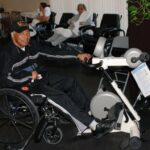Keeping Your Loved One Active
 As you watch your loved one age, you may notice him or her slowing down a bit – they may be more likely to spend time sitting down, or complain of aching muscles and bones. When we get older, our bodies become more susceptible to deteriorating; this is simply part of life. The motivation to exercise may dwindle as your loved one seeks comfort by sitting in a cushioned armchair while reading or watching television.
As you watch your loved one age, you may notice him or her slowing down a bit – they may be more likely to spend time sitting down, or complain of aching muscles and bones. When we get older, our bodies become more susceptible to deteriorating; this is simply part of life. The motivation to exercise may dwindle as your loved one seeks comfort by sitting in a cushioned armchair while reading or watching television.
Exercise is important to incorporate into your daily life at any age, but as we get older there are even more reasons why exercise is vital to good health. To name a few:
- Bone loss occurs as we get older. Muscle pulling on bone builds bone density; weight-lifting exercises can help improve the strength and density of bones in older age.
- Keeping the body in motion can help delay muscle weakening and build endurance.
- Exercising can help promote mental health, as well as physical health, by triggering the production of endorphins. Some studies have found that exercise can help boost activity in the brain’s frontal lobe and the hippocampus.
- Exercising regularly helps an individual maintain a steady routine and build self-discipline.
Beneficial Exercise Techniques For Your Loved One
- Try to go for a walk about 4-5 times per week or daily. Most doctors recommend 30 minutes of exercise per day, but even a shorter walk will help boost cardiac health by a small amount. Walks can be a great activity for caregivers and their loved ones to participate in together.
- For those without arthritis, keeping a small low-maintenance garden may be beneficial. The act of planting, weeding, and watering are good exercise for the hands and extremely therapeutic as well. The feeling of accomplishment that comes with growing plants boost mental health as well as physical health.
- Try “in-home” bowling with a ball made of soft rubber and lightweight, plastic pins.
- A bean bag toss can be a great activity with two or more people. “Volley balloon” can be a fun alternative; set up a volleyball net and hit the balloon back and forth. Don’t let it touch the ground!
- Weight lifting can be extremely important to help maintain the strength of muscles, as well as climbing stairs.
- Another fun group activity (more than two people is recommended) includes using a silk parachute. Try lifting the parachute to the rhythm of different songs. This activity helps work out the arms and shoulders.
- Swimming requires no equipment and is an aerobic exercise that is ideal for those with problem joints, like hips and knees, who are unable to do weight-bearing exercises.
Many of these activities can be done in groups, and social stimulation is always a key aspect in mental health. Try to get more people involved in activities like these to create a fun, exhilarating bonding experience!
Individuals in wheelchairs may have a harder time getting adequate exercise. Here are some exercise tips for individuals who are in wheelchairs:
- Try raising and lowering the arms at a slow and steady rate: Starting with arms at the side, raise them up to shoulder level, in front, or overhead.
- Raise and lower the feet in a “scissors” type manner.
- Raise both arms overhead and bend at the waist; to the front, left and right.
- Roll your head clockwise and counterclockwise to help loosen a stiff neck.
How Can Oxnard Family Circle Help?
 At Oxnard Family Circle Adult Day Health Care Center, we put an equal amount of focus on both mental and physical health. Oxnard Family Circle has a designated exercise area with a variety of different exercising tools and machines to help provide a range of strength and muscle-building routines. Stationary bicycles, hand bicycles, and arm pulleys help develop range of motion and the ability to stretch out sore leg and arm muscles. Oxnard Family Circle’s MOTOmed machine provides a rare opportunity for those in wheelchairs to exercise both their legs and arms. We have physical and occupational therapy to help assist with rehabilitation of the arms and legs. Oxnard Family Circle also has a Nintendo Wii with fitness games to help your loved one keep track of progress in a fun way. Your loved one is supervised to ensure that they are using the machines or exercising in a safe way that will not be damaging to their body. As always, we keep in touch with your loved one’s physician and follow up to make sure that your family member’s personalized exercise routine is as beneficial as possible.
At Oxnard Family Circle Adult Day Health Care Center, we put an equal amount of focus on both mental and physical health. Oxnard Family Circle has a designated exercise area with a variety of different exercising tools and machines to help provide a range of strength and muscle-building routines. Stationary bicycles, hand bicycles, and arm pulleys help develop range of motion and the ability to stretch out sore leg and arm muscles. Oxnard Family Circle’s MOTOmed machine provides a rare opportunity for those in wheelchairs to exercise both their legs and arms. We have physical and occupational therapy to help assist with rehabilitation of the arms and legs. Oxnard Family Circle also has a Nintendo Wii with fitness games to help your loved one keep track of progress in a fun way. Your loved one is supervised to ensure that they are using the machines or exercising in a safe way that will not be damaging to their body. As always, we keep in touch with your loved one’s physician and follow up to make sure that your family member’s personalized exercise routine is as beneficial as possible.
Always encourage your loved one to be honest about their exercising experience and work with them to find exercises that work the best for your loved one personally. Remember that everyone’s body is different and encourage your loved one to speak up if they are experiencing shortness of breath, a sudden pain in joints or muscles, or chest pain. Whenever possible, supervise your loved one’s exercising routines (or even better, exercise with them) to ensure that they are doing an adequate amount of safe exercising.
Leave a reply

Leave a reply